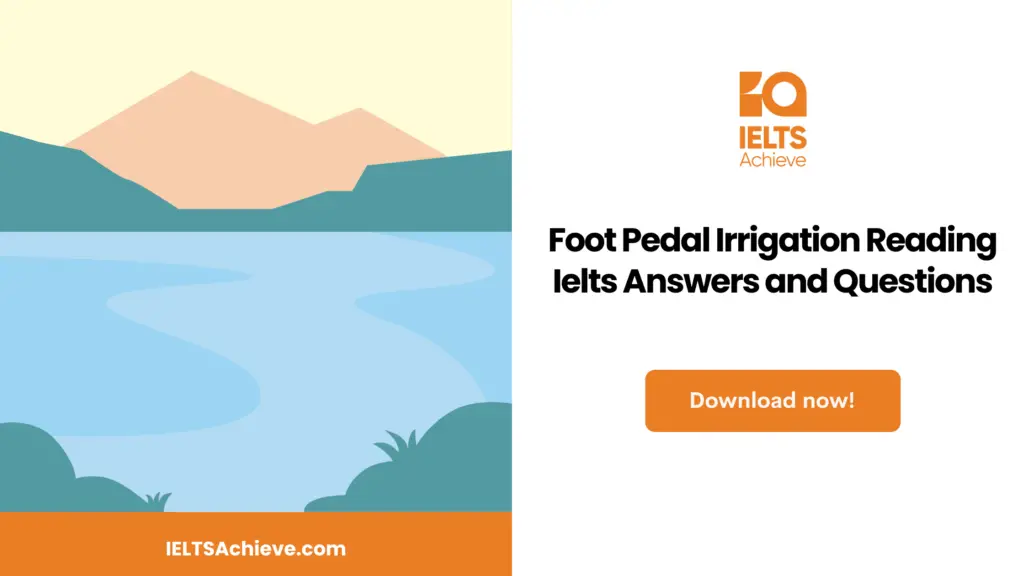The Blog post contains the following IELTS Reading Questions
- IELTS Reading Short Answer Questions
- IELTS Reading Diagram Labelling
- IELTS Reading True False Not Given
Stay informed and prepared for success – Explore our comprehensive Reading Test Info page to get valuable insights, exam format details, and expert tips for mastering the IELTS Reading section.
IELTS Reading Passage – Foot Pedal Irrigation

Foot Pedal Irrigation
Till today, numerous large-scale projects have been attempted by the government and development agencies to address the problems, including the construction of enormous dams, irrigation canals, and vast new fields of high-yield crops during the Green Revolution, the well-known campaign to increase grain harvests in developing nations. However, traditional irrigation has deteriorated the soil in many regions, and reservoirs behind dams may soon get clogged with silt, lowering their storage capacity and depriving farmers downstream of rich sediments. Furthermore, since 1950, the Green Revolution has significantly increased global agricultural productivity; nonetheless, poverty endures persistently throughout Africa, Asia, and Latin America. Local initiatives to give inexpensive, individual irrigation systems to small farms may be a more effective approach to bring people out of poverty, despite the fact that continuous increases in the productivity of big farms may play a major role in raising food supply.
It should not come as a surprise that the Green Revolution did not alleviate poverty or hunger, since its purpose was to expand the global food supply, not to boost the earnings of the rural poor. For instance, India, has been self-sufficient in food for 15 years, and its granaries are full; nonetheless, more than 200 million Indians, or one-fifth of the country’s population, are malnourished because they cannot afford the food they need and because the country’s safety nets are inadequate. In 2000, 189 countries agreed to the Millennium Development Goals, which mandated a reduction of global poverty by 2015. With business as usual, however, we have little chance of fulfilling the bulk of the Millennium Development Goals, irrespective of how much money wealthy nations donate to developing nations.
However, the supply-driven methods of the Green Revolution may not assist subsistence farmers, who must concentrate on their capabilities to remain competitive in the global market. The average size of a family in India, Bangladesh, and China is less than four acres, 1.8 acres, and around half an acre, respectively. Combines and other sophisticated agricultural equipment are too costly to utilise on such a small scale. An Indian farmer selling extra wheat produced on his one-acre plot could never compete with the huge, highly efficient, and subsidised Canadian wheat fields. Instead, subsistence farmers could capitalise on the fact that their labour costs are the lowest in the globe, providing them a relative advantage in the cultivation and sale of high-value, intensively cultivated commodities.
In 1981, when Paul Polak met Abdul Rahman, a farmer from the Noakhali area of Bangladesh, he saw the need for a small-scale approach. Abdul could only produce 700 kilogrammes of rice annually from his three-quarter-acre plots of rain-fed rice fields, although his family required less than 300 kilos. Abdul and his wife had to observe in silence while their three children survived on one meal a day or less, when the three months before the October rice harvest came in. As Polak strolled with him over the strewn fields he inherited from his father, Polak enquired as to what he needed to escape poverty. He remarked, “Water management system for his fields at a feasible budget that he can afford.”
Soon Polak learnt about the treadle pump, a simple gadget that may assist Abdul in achieving his objective. A person propels the pump by walking in place on two treadles and two bamboo handle arms. It was invented by Norwegian engineer Gunnar Barnes in the late 1970s. It may be run for several hours each day without exhausting the users if it is properly calibrated and maintained. The treadle pump consists of two cylinders constructed from engineering plastic. The diameter and height of the cylinders are respectively 100.5mm and 280mm. The maximum depth at which the pump can operate is 7 metres. In order to protect the integrity of the rubber components, operation above seven metres is not advised. Piston and foot valve components comprise the pump mechanism. The treadle movement produces alternating strokes in the two cylinders, which lifts the water in pulses.
The human-powered pump costs under $25, which includes the expense of drilling a tube well down to the groundwater, and it also can irrigate half an acre of plants. After hearing about it from a cousin, Abdul was among the first farmers in Bangladesh to purchase a treadle pump. After four months, he returned $25 easily to his uncle, which he borrowed. During the five-month dry season, when Bangladeshis generally farm relatively little, Abdul utilised the treadle pump to cultivate a quarter-acre of chilli peppers, tomatoes, cabbage, and eggplants. In addition, he increased the production of one of his rice plots by irrigating it. His family ate a portion of the veggies and sold the remainder at the local market for a net profit of $100. Abdul was able to purchase rice for his family, put his two kids in school until they were 16 years old, and lay away a little amount for his daughter’s dowry with his new income. When Polak saw him in 1984, he had quadrupled the area of his vegetable allotment and replaced the thatched roof on his home with corrugated tin. His family had a cow and many fowl. He informed me that the foot pump was a divine gift.
Bangladesh is well suited for the treadle pump since a vast pool of groundwater exists only a few metres under the feet of the farmers. IDE launched a marketing effort for the pump, supporting 75 small private-sector businesses to manufacture the devices and several thousand village merchants and tube-well drillers to sell and install them, in the early 1980s. Over the next 12 years, the farmers’ net income increased by $150 million each year since one and half million farm households acquired treadle pumps. The cost of IDE’s market-creation initiatives was just $12 million, facilitated by the farmers’ $37.5 million investment. In context, the cost to construct a traditional dam and canal system to irrigate a comparable amount of farmland would be between $2,000 and $1.5 billion per acre.
Unlock your full potential in the IELTS Reading section – Visit our IELTS Reading Practice Question Answer page now!
Recommended Questions:
Renewable Energy IELTS Reading Question with Answer
Foot Pedal Irrigation IELTS Reading Questions
Questions 1-6
Answer the question below.
Write NO MORE THAN THREE WORDS AND/OR A NUMBER from the passage for each answer.
- How large an area can a treadle pump irrigate the field affordably?
- How much did Abdul’s uncle lent him?
- What is the substance of Abdul’s new roof?
- Which animals Abdul’s family had?
- Which country is a suitable location for the treadle pump?
- How much did Bangladesh farmers invest as a consequence of IDE’s stimulation?
Questions 7-10
Filling the blanks in diagram of treadle pump’s each part.
Write NO MORE THAN THREE WORDS AND/OR A NUMBER from the passage for each answer.

Ready to tackle Diagram Label Completion tasks with confidence? Click here to access our comprehensive guide and learn how to accurately label parts or components of diagrams in the IELTS Reading section.
Questions 11-14
Answer the question from True/ False or Not Given.
TRUE if the statement agrees with the view of writer
FALSE if the statement contradicts the view of writer
NOT GIVEN if there is no information on this view
11. Early in the middle of the 20th century, the Green Revolution was unable to expand world agricultural output
12. It is more effective to resolve hunger and poverty on a wide scale than on a small one.
13. In emerging economies, the construction of enormous dams takes more time.
14. In the previous decade, small pumps expanded to major projects in Bangladesh.
Enhance your skills in identifying information as True, False, or Not Given. Click here to discover expert strategies and techniques for mastering this question type in the IELTS Reading section.
Unlock your full potential in the IELTS Reading section – Visit our IELTS Reading Practice Question Answer page now!
Recommended Questions:
Renewable Energy IELTS Reading Question with Answer
Foot Pedal Irrigation Reading Answers
1. Half an acre
2. $25
3. Corrugated tin
4. Cow and fowl
5. Bangladesh
6. $37.5 million
7. Bamboo
8. Cylinders
9. Piston
10. 7
11. False
12. False
13. Not Given
14. True

We hope you found this post useful in helping you to study for the IELTS Test. If you have any questions please let us know in the comments below or on the Facebook page.
The best way to keep up to date with posts like this is to like us on Facebook, then follow us on Instagram and Pinterest. If you need help preparing for the IELTS Test, join the IELTS Achieve Academy and see how we can assist you to achieve your desired band score. We offer an essay correction service, mock exams and online courses.

